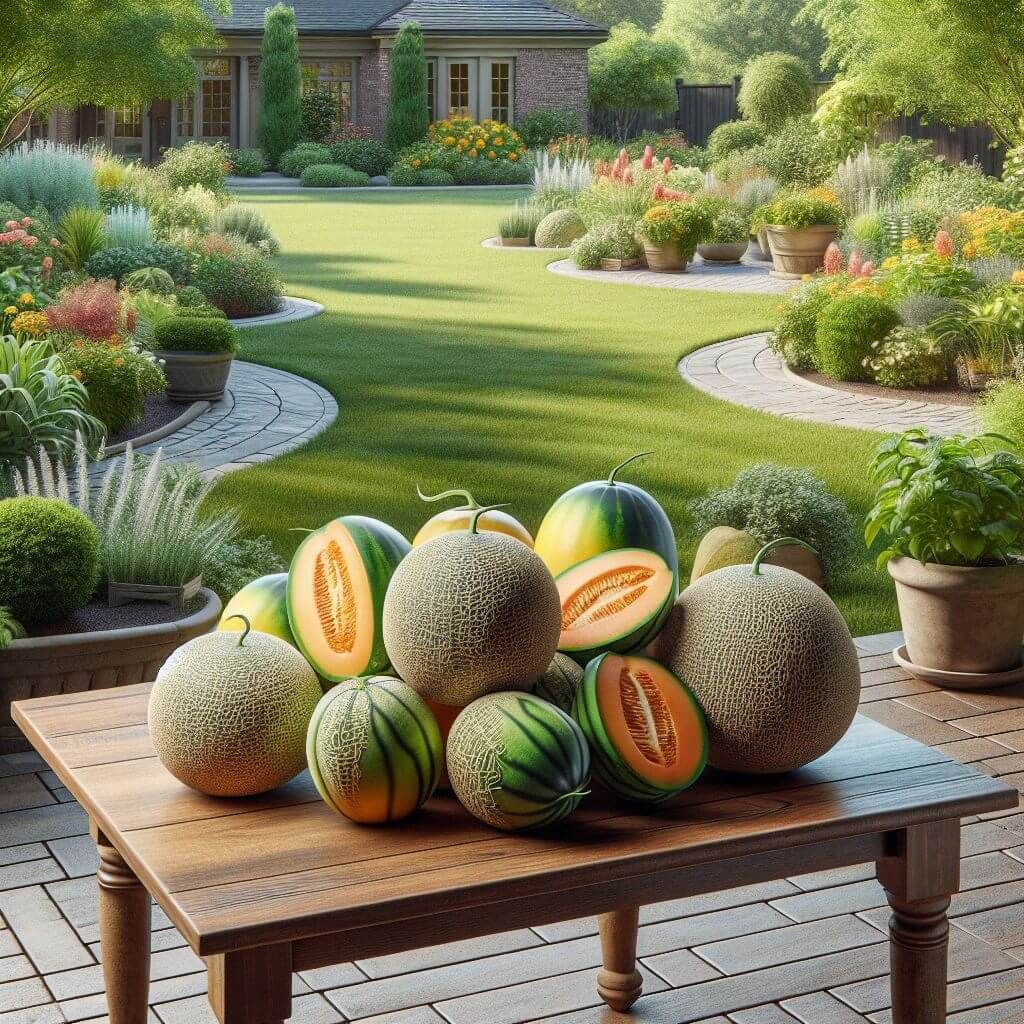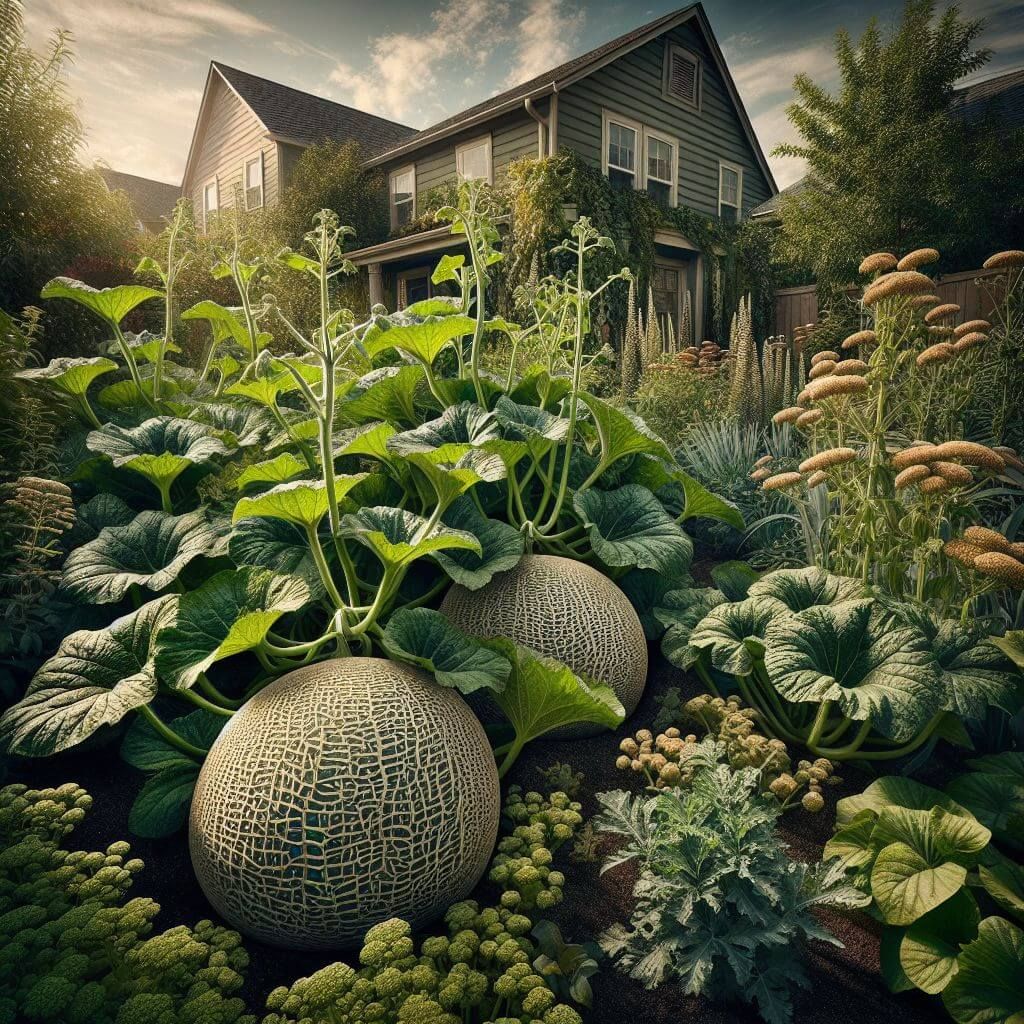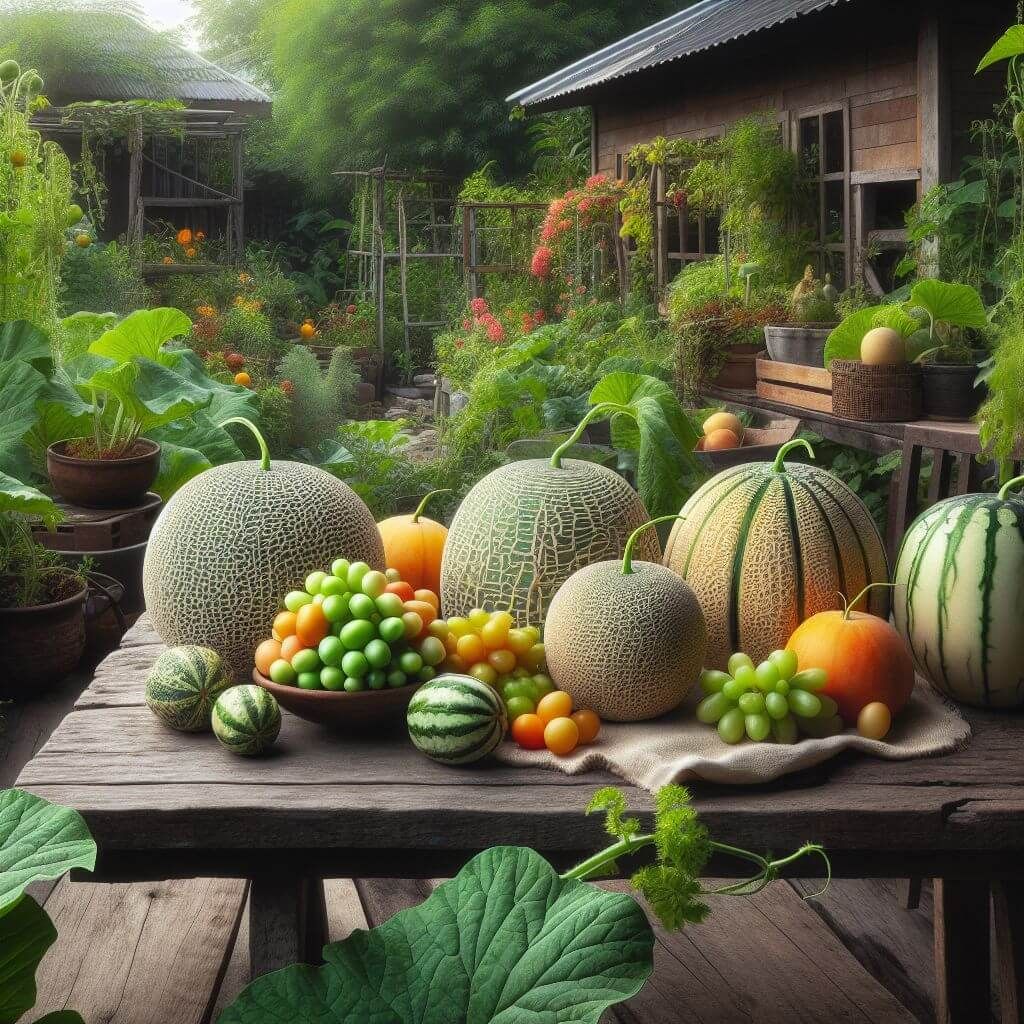
Article-at-a-Glance: Jumbo Melons for Juicy Harvests
- Hale’s Best Jumbo Cantaloupe is an heirloom variety with a reputation for large, sweet fruits.
- These melons are relatively easy to grow, making them suitable for gardeners of all levels.
- Proper site selection, soil preparation, and watering are key to a bountiful melon harvest.
- Understanding the growth cycle and harvest indicators ensures peak flavor and texture.
- Comparing Hale’s Best Jumbo to other varieties highlights its unique size and taste profile.
Why Hale’s Best Jumbo Is a Garden Gem
Imagine biting into a slice of melon so sweet and juicy that it feels like a burst of summer in your mouth. That’s the experience of savoring a Hale’s Best Jumbo cantaloupe. This heirloom variety is not just another melon; it’s a testament to the joy of home gardening and the pleasures of fresh, homegrown produce.
The Sweet Secret of Jumbo Melons
What makes Hale’s Best Jumbo stand out is its consistently large size and incredibly sweet flesh. This cantaloupe variety is known for its thick, heavy netting on the rind, which protects the succulent orange interior. But the real secret lies in its sugar content – a natural sweetness that’s hard to find in store-bought melons.
From History to Your Garden: Hale’s Best Jumbo
Developed in the 1920s, Hale’s Best Jumbo has withstood the test of time, proving to be a favorite among generations of gardeners. It was bred for its ability to thrive in varied conditions, making it a versatile choice for different climates. But don’t let its history fool you; this melon is as relevant and delightful today as it was nearly a century ago.
Cultivating Your Jumbo Melon Success

Let’s roll up our sleeves and dive into the art of growing Hale’s Best Jumbo cantaloupes. With a bit of know-how and care, you’ll be on your way to a harvest that’s both plentiful and delicious.
Choosing the Right Spot for Sowing
The first step is to choose the perfect spot in your garden. Cantaloupes love the sun, so find a space where they’ll bask in its warmth for most of the day. Make sure it’s a well-draining area because standing water is a no-go for these melons.
Soil Prep and Seed Starting Basics
Next, let’s talk soil. A rich, well-draining soil with a pH between 6.0 and 6.8 is ideal. Work in plenty of compost to give your melons a nutrient-rich start. When it comes to planting, you can either start seeds indoors about 4 weeks before the last frost or sow them directly into the ground once the soil has warmed up.
For seed starting, plant the seeds about half an inch deep in individual pots. Keep the soil moist but not waterlogged, and you’ll see sprouts in about a week. If you’re planting directly outdoors, wait until the soil temperature is consistently above 70°F, and plant the seeds in hills about 36 inches apart to give the vines room to sprawl.
Timetable for Tantalizing Taste
From the moment you plant your Hale’s Best Jumbo seeds to the day you harvest, you’re on a timeline that nature dictates. Understanding this timetable is crucial for knowing when to water, fertilize, and eventually, when to enjoy the fruits of your labor.
Germination to Growth: Key Milestones
After planting your seeds, expect germination within 7 to 14 days. The seedlings will need consistent warmth and moisture to sprout successfully. Once they emerge, it’s all about providing enough sunlight and water to promote strong growth. When your plants have 3-4 true leaves, it’s time to transplant them into the garden, spacing them about 36 inches apart to allow for vine growth.
In about 35-45 days, you’ll notice the plants starting to vine, and soon after, flowers will appear. These flowers are the precursors to your melons. Bees will be your best friends here, as they are essential for pollination. If you don’t see many bees around, you may need to hand pollinate to ensure a good crop.
Signs Your Melons Are Ready to Harvest
Harvesting at the right time is key for that peak flavor and texture. But how do you know when it’s time? There are a few tell-tale signs:
- The color of the rind changes from green to a more yellowish tone.
- The netting on the rind becomes more pronounced and feels rough to the touch.
- The melon detaches easily from the vine with a gentle twist.
- There’s a sweet, fragrant aroma near the stem end of the melon.
Typically, Hale’s Best Jumbo melons are ready to harvest 70-90 days after sowing. Mark your calendar from the planting date to keep track of the growing period.
Remember, patience is key. Resist the temptation to harvest too early. A fully ripened melon is worth the wait and will be much more flavorful than one picked prematurely.
Most importantly, once you pick your melon, it won’t continue to ripen, so timing is everything. Trust your senses and these indicators to guide you to the perfect harvest moment.
Melon Varieties: A Comparison

While Hale’s Best Jumbo is a standout variety, it’s one of many in the melon family. Let’s compare it to some other popular choices to see how it measures up.
Hale’s Best Jumbo Versus Other Popular Varieties
Hale’s Best Jumbo is known for its large size and sweetness, but how does it stack up against other varieties? Let’s consider a few:
Compared to the Honeydew, for instance, Hale’s Best Jumbo has a more robust flavor and a firmer texture. Against the smaller, more aromatic French Charentais, it offers a larger yield per fruit, making it a favorite for those who want more bang for their buck.
When pitted against the Galia, another sweet variety, the Hale’s Best Jumbo still holds its own with its larger size and classic cantaloupe taste that’s hard to beat.
- Honeydew: Mild and sweet with a smoother rind.
- French Charentais: Smaller, with a strong, sweet aroma.
- Galia: Sweet and spicy, similar to cantaloupe but smaller.
- Hearts of Gold: Known for their rich sweetness and tender flesh.
- Honey Rock: Bursting with honey-like flavor and refreshing juiciness.
Each variety has its unique qualities, but for those who want a tried-and-true classic with a history of success, Hale’s Best Jumbo is the way to go.
Size, Flavor, and Texture: What Sets Them Apart
The size of Hale’s Best Jumbo is impressive, often weighing 3-5 pounds. But it’s not just the size that makes this melon stand out; it’s the combination of sweet, musky flavor and juicy, yet firm texture that really sets it apart. For those interested in adding this variety to their survival garden, it’s an excellent choice for both its taste and nutritional value.
The texture is particularly important because it affects how the melon holds up in salads, as a stand-alone snack, or in recipes. A firmer texture means it can be sliced and presented beautifully on a platter without losing its shape or becoming mushy.
Serving Up Something Special
Once you’ve mastered the art of growing and harvesting these jumbo melons, it’s time to enjoy them. And there are countless ways to serve up Hale’s Best Jumbo cantaloupes, whether you prefer them straight off the vine or in a more elaborate dish.
Recipe Ideas for Ripe Melons
Here’s a simple yet delicious idea: scoop out the seeds, fill the center with a dollop of vanilla ice cream, and sprinkle with fresh mint. It’s a refreshing dessert that’s as easy to prepare as it is delightful to eat.
Or, for a savory twist, wrap thin slices of prosciutto around wedges of cantaloupe for a classic Italian appetizer. The sweet and salty combination is irresistible and makes for an elegant start to any meal.
Pairings and Preservations
Besides these tasty dishes, consider the following pairings to enhance your melon experience: brewing teas and tinctures from your survival garden.
- Pair with a crisp white wine or a sparkling beverage for a refreshing summer treat.
- Combine with other fruits like berries or citrus for a vibrant fruit salad.
- Use in smoothies or as a natural sweetener in yogurt or oatmeal.
And if you find yourself with more melons than you can eat, don’t fret. You can preserve the sweetness by making melon jam, freezing cubes for later use, or even pickling the rind for a unique condiment.
With Hale’s Best Jumbo, the possibilities are as plentiful as the harvest. So go ahead, plant those seeds, and get ready for a season of sweet, hydrating success in your survival garden.
Frequently Asked Questions (FAQ)
As you embark on your melon-growing journey, you might have some questions. Here are answers to some common queries, including tips on growing Hale’s Best Cantaloupe.
What Makes Hale’s Best Jumbo Unique?
Hale’s Best Jumbo is unique for its large size, sweet taste, and heavy netting on the rind that signals its readiness to be harvested. It’s an heirloom variety that has been cherished for nearly a century due to its reliable performance and delicious fruit.
How Long Does It Take for Jumbo Melons to Ripen?
On average, Hale’s Best Jumbo melons take 70-90 days from planting to ripen. However, this can vary depending on growing conditions like temperature and sunlight.
Can Jumbo Melons Grow in Containers or Small Spaces?
While Hale’s Best Jumbo melons are best suited for gardens where they have room to vine, with careful management and the right container size, it is possible to grow them in smaller spaces. Just be mindful of the reduced yield and the need for extra care.
What Are the Best Conditions for Growing Jumbo Melons?
The best conditions for growing Hale’s Best Jumbo melons are full sun, well-draining soil with a pH of 6.0-6.8, and consistent watering. Protection from pests and diseases is also crucial for a successful crop.
How Should I Store and Preserve Jumbo Melons?
To store, keep your ripe melons in the refrigerator for up to a week. For preservation, consider freezing, making jam, or pickling the rind. These methods will allow you to enjoy the flavor of your melons long after the season has ended.
Once you’ve mastered the art of growing and harvesting these jumbo melons, it’s time to enjoy them. And there are countless ways to serve up Hale’s Best Jumbo cantaloupes, whether you prefer them straight off the vine or in a more elaborate dish.
Here’s a simple yet delicious idea: scoop out the seeds, fill the center with a dollop of vanilla ice cream, and sprinkle with fresh mint. It’s a refreshing dessert that’s as easy to prepare as it is delightful to eat.
Pairings and Preservations
For a savory twist, wrap thin slices of prosciutto around wedges of cantaloupe for a classic Italian appetizer. The sweet and salty combination is irresistible and makes for an elegant start to any meal.
Besides these tasty dishes, consider the following pairings to enhance your melon experience:
- Pair with a crisp white wine or a sparkling beverage for a refreshing summer treat.
- Combine with other fruits like berries or citrus for a vibrant fruit salad.
- Use in smoothies or as a natural sweetener in yogurt or oatmeal.
And if you find yourself with more melons than you can eat, don’t fret. You can preserve the sweetness by making melon jam, freezing cubes for later use, or even pickling the rind for a unique condiment.
With Hale’s Best Jumbo, the possibilities are as plentiful as the harvest. So go ahead, plant those seeds, and get ready for a season of sweet, hydrating success in your survival garden.
Frequently Asked Questions (FAQ)
As you embark on your melon-growing journey, you might have some questions. Here are answers to some common queries:
What Makes Hale’s Best Jumbo Unique?
Hale’s Best Jumbo is unique for its large size, sweet taste, and heavy netting on the rind that signals its readiness to be harvested. It’s an heirloom variety that has been cherished for nearly a century due to its reliable performance and delicious fruit.
How Long Does It Take for Jumbo Melons to Ripen?
On average, Hale’s Best Jumbo melons take 70-90 days from planting to ripen. However, this can vary depending on growing conditions like temperature and sunlight.
Most importantly, once you pick your melon, it won’t continue to ripen, so timing is everything. Trust your senses and these indicators to guide you to the perfect harvest moment.
Can Jumbo Melons Grow in Containers or Small Spaces?
While Hale’s Best Jumbo melons are best suited for gardens where they have room to vine, with careful management and the right container size, it is possible to grow them in smaller spaces. Just be mindful of the reduced yield and the need for extra care.
Remember, patience is key. Resist the temptation to harvest too early. A fully ripened melon is worth the wait and will be much more flavorful than one picked prematurely.
What Are the Best Conditions for Growing Jumbo Melons?
The best conditions for growing Hale’s Best Jumbo melons are full sun, well-draining soil with a pH of 6.0-6.8, and consistent watering. Protection from pests and diseases is also crucial for a successful crop.
How Should I Store and Preserve Jumbo Melons?
To store, keep your ripe melons in the refrigerator for up to a week. For preservation, consider freezing, making jam, or pickling the rind. These methods will allow you to enjoy the flavor of your melons long after the season has ended.






